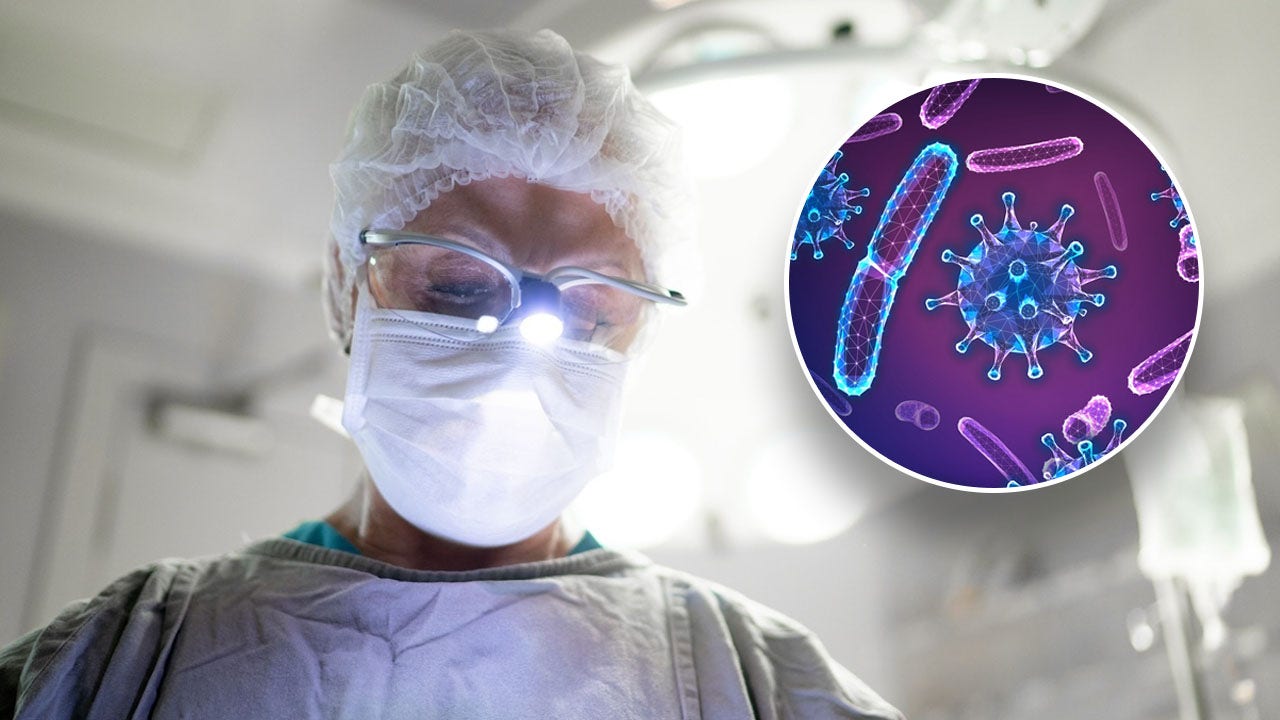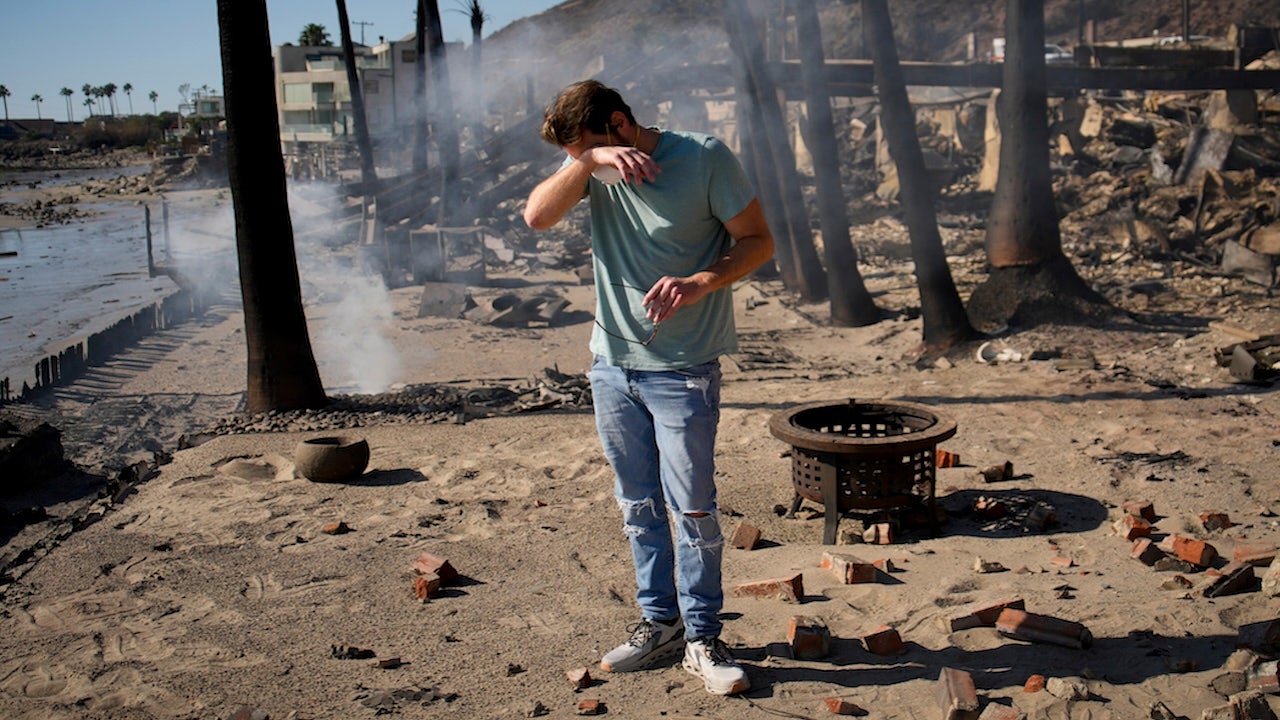Health
New surgical technology can ‘light up’ bacteria in wounds, helping to prevent infections

Up to 5% of people who have surgery can develop an infection — which can prolong healing and lead to dangerous complications, studies have shown.
Additionally, chronic wounds affect around 6.5 million patients in the U.S.
Some bacteria can’t be seen with the human eye, which means they may be missed by physicians when cleaning a wound.
Now, a new medical technology that uses fluorescent light has shown to be effective in detecting missed bacteria, according to new research led by University of Southern California, Los Angeles (USC).
BURN TREATMENT MADE FROM PINEAPPLES REDUCES NEED FOR SKIN GRAFTING SURGERY: ‘NEW AVENUE OF WOUND CARE’
In a review of 26 medical studies, a handheld device using autofluorescence (AF) imaging successfully “lit up” bacteria in nine out of 10 wounds, with each different type of bacteria turning a different color, according to a press release from USC.
The findings were published recently in the medical journal Advances in Wound Care.
A new medical technology that uses fluorescent light has shown to be effective in detecting missed bacteria. (iStock)
Real-time detection
In traditional cases, surgeons take tissue samples from wounds and send them to a lab for testing to determine the types of bacteria that are present, the researchers noted.
It can take days to get the results, during which time infection can set in.
BLOOD BANKS SEARCHING FOR TYPE O BLOOD AMID EMERGENCY SHORTAGE: ‘WE ALWAYS HAVE A NEED’
“Bacteria can cause wounds to become infected when they enter and colonize the cut or wound,” Dr. Raj Dasgupta, pulmonary and critical care specialist at Huntington Health in Los Angeles, told Fox News Digital.
“If a person does not receive treatment for a wound infection, the infection can spread to other parts of the body, which may lead to serious complications.” (Dasgupta was not involved in the new study.)

In a review of 26 medical studies, a handheld device using autofluorescence imaging successfully “lit up” bacteria in nine out of 10 wounds. (iStock)
The lighting technology allows clinicians to see bacteria in real time, leading to more targeted and effective wound care, according to the study researchers.
“Fluorescence imaging, particularly with devices like MolecuLight, offers a significant advancement in the ability to detect bacterial loads in chronic wounds, such as diabetic foot ulcers,” lead study author Dr. David G. Armstrong, professor of neurological surgery and director of the USC Limb Preservation Program, told Fox News Digital.
“If a person does not receive treatment for a wound infection, the infection can spread to other parts of the body, which may lead to serious complications.”
It could also help prevent the need for antibiotics, as the bacteria can be removed before infection occurs.
“The study also explores the potential of wearable fluorescence imaging devices, which could further revolutionize surgical debridement by providing continuous visualization during the procedure,” Armstrong added.

The lighting technology allows clinicians to see bacteria in real time, leading to more targeted and effective wound care, according to the study researchers. (iStock)
One of the most surprising discoveries in the study was that high amounts of bacteria didn’t always cause symptoms, but still slowed down the healing process, the researchers stated.
This highlighted the need for “more sophisticated diagnostic tools” in wound management.
OZEMPIC PATIENTS MAY FACE DANGEROUS RISKS DURING SURGERY, DOCTORS WARN
“The big idea here is that we might be able to get out in front of an infection before having to give someone antibiotics,” said Armstrong. “This is the ultimate kind of stewardship to promote superbugs.”
Based on this study, Armstrong recommends that clinicians consider integrating fluorescence imaging into their standard wound care protocols, especially for chronic wounds like diabetic foot ulcers.
“The big idea here is that we might be able to get out in front of an infection before having to give someone antibiotics.”
“This technology not only improves the accuracy of debridement, but also aids in early intervention, potentially reducing the risk of complications like infections and amputations,” he told Fox News Digital.
“We also recommend that health care providers stay informed about advancements in wearable imaging technologies, which may soon provide even greater flexibility and precision in wound care.”
Fluorescence may not replace lab testing, surgeon says
Dr. Patrick Davis, a facial plastic surgeon at Davis Facial Plastics in Beverly Hills, California, emphasized the importance of preventing bacterial infections — especially for revision rhinoplasties, which he said have a higher risk of this type of complication.

“This technology not only improves the accuracy of debridement, but also aids in early intervention, potentially reducing the risk of complications like infections and amputations,” a researcher said. (iStock)
“There has been modest research with the use of fluorescence to illuminate a particular wound bed,” Davis, who was not involved in the new study, told Fox News Digital.
“The idea is that certain bacteria will emit a certain wavelength of light. Staph infections, for example, would emit a different color than another type of bacteria.”
CLICK HERE TO SIGN UP FOR OUR HEALTH NEWSLETTER
This can be helpful in confirming what kind of antibiotic to use for treatment, Davis noted, while also telling the surgeon the “burden of bacteria,” which indicates the level of bacteria in the wound.
The use of this technology still needs more research, according to the surgeon.

The technology could help prevent the need for antibiotics, as the bacteria can be removed before infection occurs. (iStock)
“At this time, this technology would not replace a simple swab of the area and then a laboratory test determining exactly what type of bacteria is present and what antibiotic to use,” he said.
“However, this technology can give a real-time hint at the family of bacteria that is present, although it may not be so specific — that is still reserved for a laboratory to determine.”
Dasgupta agreed that this device could be a “safe, effective, accurate and easy-to-use tool” to improve the assessment of wounds, but he noted that fluorescent light imaging has some limitations when used to detect bacterial infections.
DOCTORS INCREASINGLY USING AR SMART GLASSES IN OPERATING ROOM: ‘POTENTIAL TO REVOLUTIONIZE SURGERIES’
“The evaluation is limited to bacteria that produce fluorescent molecules on the skin’s surface and subsurface,” Dasgupta told Fox News Digital.
“The detection ability is also dependent on the number of bacteria present in the wound,” he went on. “Also, wound depth cannot be captured with this type of evaluation.”
Study limitations
The primary limitation of this study is that it depended on “controlled lighting conditions” in order for the fluorescence imaging devices to function accurately, Armstrong noted.
For more Health articles, visit www.foxnews.com/health
“This could be a challenge in certain clinical settings, particularly in real-time surgical environments,” he said.
Chronic wounds affect around 6.5 million patients in the U.S.
More research is also needed to confirm the effectiveness of wearable devices compared to the existing handheld devices.
The study is partially funded by the National Institutes of Health, the National Institute of Diabetes and Digestive and Kidney Diseases, and the National Science Foundation’s Center to Stream Healthcare in Place.

Health
Deep sleep can keep two big health problems at bay, new studies suggest

It might be worth working a little bit harder to get that much-desired, but often elusive, good night’s sleep.
Deep sleep clears the mind of waste just as a “dishwasher” cleans dirty plates and glasses, just-published research suggests — and there’s more.
The findings also offer insights into how sleeping pills may disrupt the “brainwashing” system — potentially affecting cognitive function for people over the long run.
ANOTHER REASON TO GET MORE SLEEP AND THIS ONE MIGHT SURPRISE YOU
Study senior author professor Maiken Nedergaard of the University of Rochester and the University of Copenhagen said norepinephrine (a neurotransmitter and hormone) triggers blood vessels to contract — generating slow pulsations that create a rhythmic flow in the surrounding fluid to carry away waste, news agency SWNS noted.
Said Nedergaard, “It’s like turning on the dishwasher before you go to bed and waking up with a clean brain. . . . We’re essentially asking what drives this process and trying to define restorative sleep based on” this “glymphatic clearance.”
“It’s like turning on the dishwasher before you go to bed and waking up with a clean brain.” (iStock)
The brain has a built-in waste removal process – the glymphatic system – that circulates fluid in the brain and spinal cord to clear out waste, according to the scientists.
The process helps remove toxic proteins that form sticky plaques linked to neurological disorders, such as Alzheimer’s disease.
But the scientists indicated that what drives the system was unclear until now, according to the study.
Is all sleep created equal? The researchers wanted to find out.
To find clues, Nedergaard and her team looked into what happens in mice when their brains sleep, as SWNS reported of the study. The team focused on the relationship between norepinephrine and blood flow during deep sleep.
TRUMP’S DAYLIGHT SAVING PLAN AND SLEEP: WHAT YOU MUST KNOW
They found that norepinephrine waves correlate to variations in brain blood volume — suggesting that norepinephrine triggers a rhythmic pulsation in the blood vessels. The researchers then compared the changes in blood volume to brain fluid flow.
The brain fluid flow fluctuates in correspondence to blood volume changes, suggesting the vessels act as pumps to propel the surrounding brain fluid to flush out waste.

During deep sleep, toxic proteins that form sticky plaques linked to neurological disorders such as Alzheimer’s disease are removed, scientists say in a new study. (iStock)
Natalie Hauglund of the University of Copenhagen and the University of Oxford, the study’s lead author, said, “You can view norepinephrine as [the] conductor of an orchestra.”
She added, “There’s a harmony in the constriction and dilation of the arteries, which then drives the cerebrospinal fluid through the brain to remove the waste products.”
‘I CAN’T SLEEP BECAUSE OF RACING THOUGHTS AT NIGHT — HOW CAN I STOP THEM?’: ASK A DOCTOR
Hauglund said she wanted to understand whether all sleep is created equal.
To find out, the research team administered zolpidem, a common drug to aid sleep, to mice.
“If people aren’t getting the full benefits of sleep, they should be aware of that, so they can make informed decisions.”
They found that the norepinephrine waves during deep sleep were 50% lower in zolpidem-treated mice than in naturally sleeping mice.
Although the zolpidem-treated mice fell asleep more quickly — fluid transport into the brain dropped more than 30%, as SWNS reported.

Two new studies indicate the importance of getting a good night’s sleep — with one study saying a lack of sleep may be sabotaging the brain’s ability to keep intrusive thoughts at bay. (iStock)
The researchers say their findings, published in the journal Cell, suggest that the sleeping aid may disrupt the norepinephrine-driven waste clearance during sleep.
Hauglund said, “More and more people are using sleep medication, and it’s really important to know if that’s healthy sleep. If people aren’t getting the full benefits of sleep, they should be aware of that, so they can make informed decisions.”
CLICK HERE TO SIGN UP FOR OUR HEALTH NEWSLETTER
The research team said the findings likely apply to humans, who also have a glymphatic system, although it requires further testing.
Nedergaard added, “Now we know norepinephrine is driving the cleaning of the brain, we may figure out how to get people a long and restorative sleep.”
For more Health articles, visit www.foxnews.com/health
Meanwhile, a lack of sleep may be doing more damage than just making people groggy.
It could be sabotaging the brain’s ability to keep intrusive thoughts at bay.

Anyone who suffers from sleep deprivation may find that the brain’s defense against unwanted memories is weakened, say experts. (iStock)
Another new study, this one published in the Proceedings of the National Academy of Sciences, found that sleep deprivation weakens the brain’s defense against unwanted memories, allowing them to flood the mind, according to the New York Post.
“We show that sleep deprivation disrupts prefrontal inhibition of memory retrieval, and that the overnight restoration of this inhibitory mechanism is associated with time spent in rapid eye movement (REM) sleep,” the scientists said.
Health
How Kathy Bates Lost 100 Lbs—Plus Her Tips for Sustainable Weight Loss

Sign Up
Create a free account to access exclusive content, play games, solve puzzles, test your pop-culture knowledge and receive special offers.
Already have an account? Login
Use left and right arrow keys to navigate between menu items.
Use escape to exit the menu.
Health
California fires and mental health toll: Celebrities and therapists offer tips

As Los Angeles battles the worst wildfires in the city’s history, thousands of people have been displaced or have seen their homes burn to the ground.
Around 130,000 people were ordered to evacuate and some 10,000 structures were destroyed, according to the Associated Press. At least 10 people have died as a result of the blazes.
The devastation of the fires has undoubtedly taken a grave toll on the psyches of those affected, experts agree.
STEVE GUTTENBERG CALLS LA WILDFIRES ‘GREAT EQUALIZER,’ URGES PEOPLE TO LEAN ON ONE ANOTHER
Fox News Digital spoke with celebrities and mental health experts, who offered the following guidance for the people impacted.
Recognize your feelings
For those who have experienced a loss from the fires, common reactions include shock, disbelief and confusion, according to David Kessler, a grief counselor in Los Angeles and founder of Grief.com.
“I call it grief brain,” he told Fox News Digital.
Luke Dexter reacts as he sifts through the remains of his father’s fire-ravaged beachfront property in the aftermath of the Palisades Fire on Jan. 10, 2025 in Malibu, Calif. (AP Photo/John Locher) (AP Newsroom)
“Your mind is trying to comprehend what happened, and it’s a hard thing for it to do, because this is unimaginable that your house, your safety, is suddenly gone.”
Not all grief is related to death, Kessler noted, as there are many different types of losses.
“I always say grief is a change you didn’t want — and certainly a fire is a change we didn’t want,” he added.
WHAT IS PTSD? SYMPTOMS THAT CAN EMERGE AFTER EXPERIENCING A TRAUMATIC EVENT
It’s important to “self-validate” the reality of the loss, he said.
“People might give you toxic positivity of, ‘well, at least no one died,’” he said. “And while that’s true, the reality is you still have lost your home. Don’t let anyone minimize that.”
“The loss of a home is devastating and it can take years to recover.”
“I think we’re going to deal with a lot of depression after this, a lot of sadness.”
Actor Steve Guttenberg, who lives in Pacific Palisades, California, where fires erupted on Tuesday, shared how the disaster has impacted his own mental health.
“I’ve seen so much tragedy the last three or four days that I’ve got to be careful to … keep a hold of my mind,” he said in an interview with Fox News Digital.
“And I think that we’re going to deal with a lot of depression after this, a lot of sadness. And it’s going to be really tough because this is like nothing you’ve ever seen.”

Actor Steve Guttenberg, who lives in Pacific Palisades, California, where fires erupted on Tuesday, shared how the disaster has impacted his own mental health. (AGUSTIN PAULLIER/AFP via Getty Images; Fox News)
Gutenberg noted that while it’s “very normal” to be down, he is trying not to let himself “go down that hole.”
“But I’m pretty sad about this,” he added.
HOW TO COPE WITH ‘COLLECTIVE GRIEF’ WHEN MASS TRAGEDY STRIKES
Jonathan Alpert, a psychotherapist in Manhattan and Washington, D.C., noted that the grief following the Los Angeles fires is “profound.”
“It’s not just about the physical loss of homes or belongings — it’s also about the sense of safety and normalcy that has been lost,” he told Fox News Digital.
“It’s important for people to feel emotions and not ignore them. This is a normal reaction to such overwhelming loss and tragedy.”
Reach out for support
Guttenberg emphasized the importance of maintaining connections with others and drawing support from the community during a disaster of this magnitude.
“We’re social animals — we need people,” he said. “So I’m reaching out to my friends. There’s no way to meet right now because it’s so dangerous — so the best thing you cn do … is call and reach out and maybe you can drive somewhere.”

Experts agreed that it’s essential to avoid isolating yourself after a loss. “We need to be taken care of. We need other people around us.” (AP Newsroom)
Most of the people in town have evacuated, he pointed out. “There’s probably 10% of the population left here. Or less.”
Kessler reiterated that connection is critical after this type of trauma. “We need to be taken care of. We need other people around us. People equal safety,” he said.
“We need other people around us. People equal safety.”
Pastor Jesse Bradley of Grace Community Church outside Seattle, Washington, agreed that it’s essential to avoid isolating yourself after a loss.
“We need God and we need each other. Community is vital,” he told Fox News Digital.
“Family, friends and neighbors care about you. God sends His love through these people. Reject isolation. Don’t shut down and don’t shut people out.”
Take action
“In times of crisis such as this, regaining even small amounts of control can be grounding,” Alpert said.
He recommends creating a plan for what’s next, whether it’s finding temporary housing, accessing local resources or starting the process of rebuilding.
“Taking action — no matter how small — can help you move forward.”

Ben Treger hugs his wife Sarah Treger after finding his grandfather’s watches at the remains of their Pacific Palisades home on Thursday, Jan. 9, 2025. “If you do have survivor’s guilt, I always say the best thing is to take action,” one expert advised. (Juan Carlo/Imagn)
Kessler agreed, noting that people who are in the area but did not experience loss may feel a sense of relief mixed with guilt.
“If you do have survivor’s guilt, I always say the best thing is to take action,” he advised.
In the longer term, advocacy efforts can be a powerful tool in dealing with trauma, Alpert noted.
MIKE POSNER REVEALS HOW FAITH REDIRECTED HIS LIFE, OFFERS ADVICE ON SPENDING HOLIDAYS WITH FAMILY
“Working to improve fire prevention policies, supporting relief efforts or helping neighbors rebuild can provide a sense of purpose and empowerment during this difficult time,” he said.
Some people may be angry about the systems that failed to prevent the fires in the first place, Alpert acknowledged, and this anger can be a “powerful motivator.”
“Taking action — no matter how small — can help you move forward.”
“Use that energy to demand better, but don’t get stuck on the anger,” he advised.
“By holding leaders accountable for the policies — or lack thereof — that contributed to this devastation, and by asking the right questions and demanding answers, you might start to feel better.”
Seek professional help as needed
“The L.A. fires no doubt will not just leave physical scars, but deep emotional ones, too,” Alpert said.
“For many people, the fear, panic and helplessness experienced during the fires don’t just disappear — they linger, creating flashbacks, anxiety and difficulty functioning.”

“For many people, the fear, panic and helplessness experienced during the fires don’t just disappear — they linger, creating flashbacks, anxiety and difficulty functioning.” (iStock)
In many cases, this can lead to post-traumatic stress disorder (PTSD). Symptoms of this condition can include vivid memories of the fires, nightmares, hypervigilance or avoidance of anything that reminds someone of the event, Alpert said.
“It’s important to see this not as weakness, but rather, the mind’s and body’s way of trying to cope with extreme stress.”
“While the fires were devastating, they don’t diminish your strength or character.”
As you seek help, it’s also important to understand that PTSD doesn’t define you, he added.
“It’s a part of your experience, not your identity. While the fires were devastating, they didn’t diminish your strength or character.”
Lean on your faith
For those who have experienced traumatic grief, Kessler emphasized the importance of faith and spirituality.
CLICK HERE TO SIGN UP FOR OUR HEALTH NEWSLETTER
“They help ground us in a world full of fear,” he said. “And when we’ve lost everything, it can feel like our faith is the one thing we have to hold onto.”
During a time of crisis, Guttenberg said it’s important to “rely on anything that you believe in.”

Cesar Plaza becomes emotional while looking at his home destroyed by the Eaton Fire in Altadena, California, on Jan. 9, 2025. “It’s easy to be consumed with what you no longer have,” a pastor told Fox News Digital. (AP Photo/Nic Coury) (AP Newsroom)
“If you believe in your mom and dad, you rely on them, your brothers and sisters, your friends, your family. God, the universe.”
Above all, he added, “Just remember, you’re not alone. God is always with you. Jesus is always with you. You’ve got to hang on to that.”
Find ways to exercise gratitude
During times of hardship, it’s important to recognize the good things that are still in your life, Pastor Bradley said.
“It’s easy to be consumed with what you no longer have,” he told Fox News Digital.
For more Health articles, visit www.foxnews.com/health
“You need to be intentional to take inventory of the blessings in your life. For example, you might lose a home or business, but you still have family.”
This mindset will help you keep a healthy perspective and protect gratitude, Bradley added.
-

 Politics1 week ago
Politics1 week agoNew Orleans attacker had 'remote detonator' for explosives in French Quarter, Biden says
-

 Politics1 week ago
Politics1 week agoCarter's judicial picks reshaped the federal bench across the country
-

 Politics1 week ago
Politics1 week agoWho Are the Recipients of the Presidential Medal of Freedom?
-

 Health6 days ago
Health6 days agoOzempic ‘microdosing’ is the new weight-loss trend: Should you try it?
-

 World1 week ago
World1 week agoSouth Korea extends Boeing 737-800 inspections as Jeju Air wreckage lifted
-
/cdn.vox-cdn.com/uploads/chorus_asset/file/25822586/STK169_ZUCKERBERG_MAGA_STKS491_CVIRGINIA_A.jpg)
/cdn.vox-cdn.com/uploads/chorus_asset/file/25822586/STK169_ZUCKERBERG_MAGA_STKS491_CVIRGINIA_A.jpg) Technology3 days ago
Technology3 days agoMeta is highlighting a splintering global approach to online speech
-

 World1 week ago
World1 week agoWeather warnings as freezing temperatures hit United Kingdom
-

 News1 week ago
News1 week agoSeeking to heal the country, Jimmy Carter pardoned men who evaded the Vietnam War draft














